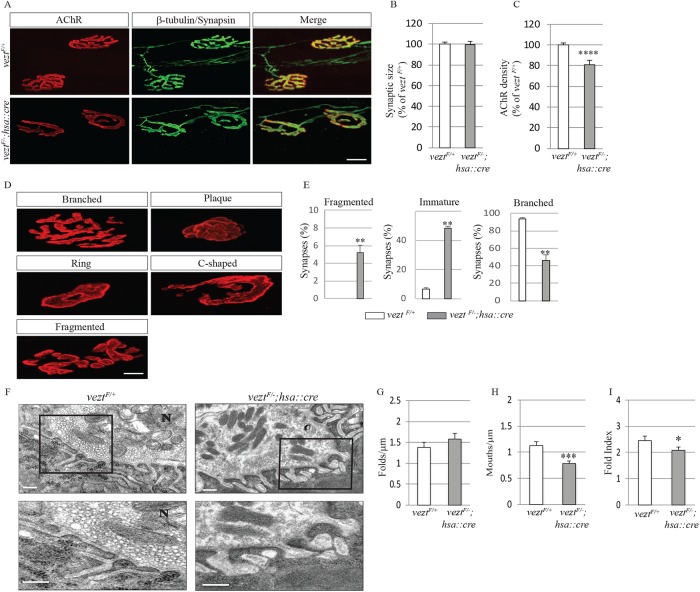FIGURE 5:
Vezatin is required for the maturation of neuromuscular synapses. (A) Diaphragm muscles from P60 veztF/+ and veztF/−; hsa::cre mice were stained with Alexa 594–conjugated α-BGT, β-tubulin, and synapsin to visualize AChRs (red) as well as axons and nerve terminals (green). Scale bar = 10 μm. (B, C) In the absence of vezatin, synaptic size was normal but the density of synaptic AChRs was reduced. (D, E) In the absence of vezatin, most neuromuscular synapses remained immature and more synapses were fragmented, whereas synapses in control mice were largely branched and complex. Mature synapses were defined as containing three to five gaps in AChR-rich areas while immature synapses were defined as containing ≤2 gaps in AChR-rich areas. Fragmented synapses were defined as containing >5 gaps in AChR-rich areas (Latvanlehto et al., 2010). Error bars indicate SEM. Values were obtained from n = 3 mice (286 synapses for veztF/+ and 232 synapses for veztF/−; hsa::cre). Scale bar = 20 µm. (F) In the absence of vezatin, nerve terminals (N), containing normal numbers of synaptic vesicles and mitochondria, are apposed to the postsynaptic membrane with postjunctional folds. The postsynaptic membranes in both veztF/+ and veztF/−; hsa::cre mice are electron dense at the crests and upper portions of the postjunctional folds. Scale bar = 500 nm. (G–I) The number of postjunctional folds (folds/μm) was normal, while the fold index and fold mouths/μm were reduced in veztF/−; hsa::cre mice. Fold index was calculated by dividing the length of the total postjunctional fold membrane by the length of the synaptic cleft. Fold mouths were defined as openings to the synaptic cleft (Friese et al., 2007). Error bars indicate SD. Values were obtained from n = 3 mice (48 synapses for veztF/+ and 81 synapses for veztF/−; hsa::cre). p values were calculated using an unpaired t test (*, p < 0.05; **, p < 0.005; ***, p < 0.0005; ****, p < 0.00005).

